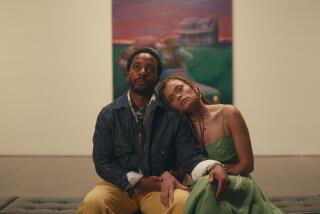THEATER REVIEW : Adding Depth to Artist’s Life : The biographical drama draws on the tension between Albert P. Ryder’s love of nature and his hermetic existence.
- Share via
NORTH HOLLYWOOD — What a strange painter Albert P. Ryder was. What a strange little play “Ryder” is.
Like the miniature oils of impassioned land scapes, cloudscapes and allegories this turn-of- the-century American painter produced with obsessively slow deliberation, Michael Holmes’ biographical portrait at the Chandler Studio builds layer upon layer of emotion in a tiny space. And like Ryder himself, it is almost self-consciously Quixotic, truly determined to create rich drama out of a solitary painter’s life, even as a host of previous artist plays and films suggest how nearly impossible that is.
Indeed, the only two recent successful dramas about art-making--Jacques Rivette’s “La Belle Noiseuse” and Peter Greenaway’s “The Belly of an Architect”--work because the former devotes long stretches of playing time to the act of painting, while the latter is shot amid the actual architecture of Rome. “Ryder” has neither the time nor the space for any kind of you-are-there biography.
Because nearly all of Ryder’s work was painted on such small surfaces as cigar box lids, and because his early years are virtually undocumented, Holmes’ jobs as both adapter and director were fairly awesome. Imagine the turbulent colors, glows and movement of J.M.W. Turner’s sky paintings mixed with the dark eddies and disturbances of Edvard Munch’s art, and one might get a sense of this obscure painter’s opus.
But Turner’s and Munch’s canvases are nearly as large as their lives; Ryder’s life was so unadventurous that he didn’t even do much of the then-obligatory European touring. In a reverse of the usual life-to-stage adaptation, Holmes has had to expand on this man’s life rather than trim away detail.
“Ryder” becomes a tale of the tension between an artist’s love of gigantic nature and his own hermetic, claustrophobic existence in a trash-filled New York apartment. Surrounding him at various stages is a small set of wildly different friends, from the tragic Christopher (Steve Evans) who helped inspire perhaps Ryder’s most distinctive and disturbing work, “The Race Track,” to seaman Capt. Robinson (Rob Daniel) to New Yorkers Charles and Louise Fitzpatrick (James Michael Connor and Susan Savage) who look after Ryder like parents visiting a destitute son.
Unfortunately for Joseph Dean Vachon as Ryder, most of the play takes place during the time when Ryder almost too easily fit the stereotype of the half-crazed, tortured artist. Vachon gives a glimpse of the younger man and his rebellious New England nature. But for too much of the play he must flail about stage talking to himself, nervously pacing, kicking around debris and emitting a hyena-like laugh that’s too actorish by half. This is physically stunning stuff, but self-consciously so.
It also doesn’t make up for not being able to view Ryder’s paintings, which here are carefully reproduced but tiny props. Only a camera close-up might allow us a view (though, at the end, “The Race Track” becomes visible as it’s hung on a wall). Thus, it’s a stretch for the audience to grasp that Ryder is a dynamic original, in the rank of Winslow Homer.
At other times, Holmes inserts superbly surprising scenes, as when Ryder is aboard Robinson’s ship, when we can imagine nature’s immensity nearly driving the painter to tears. “Ryder” might be screaming to be a film, but it contains enough moments on stage to suggest the artist’s inner turmoil, if not his outer world.
WHERE AND WHEN
What: “Ryder.”
Location: Chandler Studio, 12443 Chandler Blvd., North Hollywood.
Hours: 8 p.m. Fridays through Sundays. Ends July 17.
Price: $12.50.
Call: (818) 780-6516.
More to Read
The biggest entertainment stories
Get our big stories about Hollywood, film, television, music, arts, culture and more right in your inbox as soon as they publish.
You may occasionally receive promotional content from the Los Angeles Times.










